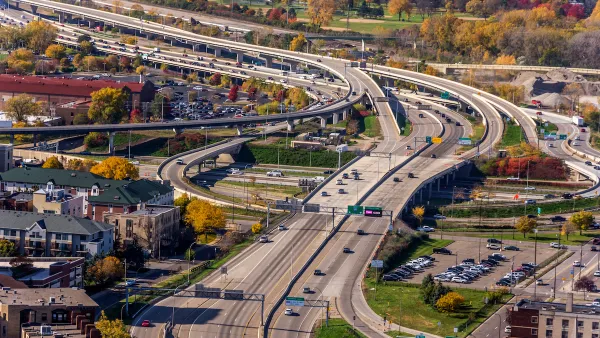The two states both approved measures that will set VMT reduction goals and create enforcement mechanisms to promote more climate-friendly policies.

Minnesota and California both recently made decisions that will help their states meet the goal of reducing vehicle miles traveled (VMT), reports Rayla Bellis in SSTI. Minnesota's Department of Transportation (MnDOT) "made a highly anticipated decision to adopt a number of recommendations from the state’s Sustainable Transportation Advisory Council (STAC) made in December 2020, including setting a preliminary statewide goal for a 20% VMT reduction statewide and per capita by 2050," with the final figure to be determined after a public input process. "MnDOT also plans to develop an approach for estimating program and project VMT outcomes by assessing both induced demand from adding lanes and reduced demand from increasing walking access, as well as evaluating the accuracy of travel demand forecasting methods."
On the West Coast, the California State Transportation Agency (CalSTA) released a draft of its Climate Action Plan for Transportation Infrastructure (CAPTI). The draft "comprises 28 action items, intended to 'help advance a slate of projects that meet climate goals, ensure that these projects are prioritized for state funding, and promote project construction and operations that minimize emission and impacts from climate change.'" In addition to meeting climate goals, CAPTI "also seeks to address the transportation system’s entrenched inequities, such as pollutants that disproportionately affect low-income and minority communities" through a stronger emphasis on equity and a new equity assessment tool.
FULL STORY: Minnesota and California move toward reducing VMT to address climate change

National Parks Layoffs Will Cause Communities to Lose Billions
Thousands of essential park workers were laid off this week, just before the busy spring break season.

Retro-silient?: America’s First “Eco-burb,” The Woodlands Turns 50
A master-planned community north of Houston offers lessons on green infrastructure and resilient design, but falls short of its founder’s lofty affordability and walkability goals.

Delivering for America Plan Will Downgrade Mail Service in at Least 49.5 Percent of Zip Codes
Republican and Democrat lawmakers criticize the plan for its disproportionate negative impact on rural communities.

Test News Post 1
This is a summary

Test News Headline 46
Test for the image on the front page.

Balancing Bombs and Butterflies: How the National Guard Protects a Rare Species
The National Guard at Fort Indiantown Gap uses GIS technology and land management strategies to balance military training with conservation efforts, ensuring the survival of the rare eastern regal fritillary butterfly.
Urban Design for Planners 1: Software Tools
This six-course series explores essential urban design concepts using open source software and equips planners with the tools they need to participate fully in the urban design process.
Planning for Universal Design
Learn the tools for implementing Universal Design in planning regulations.
EMC Planning Group, Inc.
Planetizen
Planetizen
Mpact (formerly Rail~Volution)
Great Falls Development Authority, Inc.
HUDs Office of Policy Development and Research
NYU Wagner Graduate School of Public Service





























